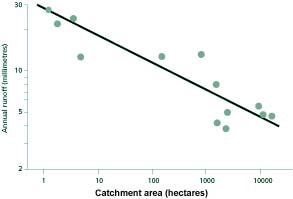| |
NETWORKING |
|
| Carrying a torch to dark zones |
||
INITIATIVE |
||
| Helping themselves Bank loans to harvest water Where there's a will,there's a way |
||
POLICY |
||
| Watershed development: what next |
||
TECHNOLOGY |
||
| Creating their own water world Simple yet effective |
||
TRADITION |
||
| The dharma of water |
||
FUNDING AGENCY |
||
| Netherlands Development Cooperation Programme |
||
CAMPAIGN |
||
| Concern for common resources Schools efforts We beg to differ |
||
DROUGHT |
||
| A stark reality |
||

Vol. 2
No.
6
December 2000
![]()
We beg to differ
Activists are often accused of promoting solutions and ideas that are impractical and unscientific. Well, we beg to differ. Our promotion of decentralised small scale structures as a solution to drought-proof the country is based on science, not fiction.
In their haste to prove small scale structures unscientific water experts often make claims which are totally unscientific as they are neither based on fact nor on science.
The December 14, 2000 issue of The Indian Express carried an article that pointed out that small might not be beautiful when it come to the size of dams in Gujarat. The article highlighted the observations made by Prof V Subramanium of the School of Environmental Studies, Jawaharlal Nehru University. According to Subramanium "Check dams in Gujarat had collected less water after the monsoon".
A representative of Centre for Science and Environment (CSE) went to meet Subramanium to know the factors believe for his claim. Subramanium's visit to the villages of Saurashtra and Kachch made him believe that small structures were ineffective. Water was available in the upstream villages because of the water harvesting work. But the villages downstream were devoid of it. He is convinced that micro systems are bound to fail if they are applied on mega scale. Interestingly, Subramanium had no science or evidence to support his claims.
Without getting into the issue of large versus small dams, there are several studies that have ascertained that small are still beautiful when it comes to size of dams.
The Central Soil and Water Conservation Research and Training Institute in Dehra Dun have conducted various studies in India, establishing a clear relationship between size of water catchment and amount of runoff that can be captured. By increasing the size of the catchment from 1 hectare (ha) to about 2 ha the water yield reduces by as much as 20 per cent per hectare.
The work of Israeli scientist Michael Evenari is revealing. In his study, Evenari came up with findings from the Negev desert where the average annual rainfall is a mere 105 millimeters (mm). The efficiency of runoff collected is more from small catchments as compared to large catchments. This is because in larger watersheds, water had to cover larger area before it got collected. A part of it got lost in puddles and depressions, as soil moisture and through
Table 1: Small size, high yields |
||
Area (hectares) |
Numbers of years for which the record was maintained |
Mean annual runoff (mm/year) |
1.30 |
13 |
27.6 |
151 |
15 |
12.7 |
1,550 |
12 |
8.2 |
9,510 |
13 |
5.7 |
14,900 |
18 |
4.7 |
evaporation. While a 1ha watershed in the Negev yielded as much as 95 cubic metres (cum) of water per hectare per year, a 345 ha watershed yielded only 24 cum/ha/year. During drought years with less than 50 mm of rainfall, watersheds larger than 50 ha will not produce any appreciate water yield while small watersheds will yield 20-40 cum/ha/ and microcatchments (smaller than 0.1 ha) as much as 80-100 cum/ha.
Graph 1: Declining yields |
 |
| Source: W C Boughton
and J J Stone 1985, Variation of runoff with watershed area in a semi-arid location, in Journal of Arid Environment, Vol.9, Academic Press, London, p.13-25 |
A study carried out by the United States department of agriculture in the semi-arid area of Arizona (355 mm annual rainfall) over ten years substantiates this argument. The study found that for every ten-fold increase in the catchment are, the average annual runoff went down by about 36 per cent (see Table 1: Small size, high yields and Graph 1: Declining yields). The study concluded that there was a 99 per cent probability of getting an annual average runoff of 3.6 mm from a 1.3 hectares catchment whereas the runoff with the same probability from a 14,900 ha catchment was only 0.2 mm. Similarly, a 1.3 ha catchment had a 1 per cent probability of giving an annual runoff of 76.2 mm whereas a 14,900 ha catchment would give only 16.8 mm.
In simple words, this indicates that in a drought prone area, 10 tiny dams with a catchment of 1 ha each will collect more water than one larger dam with a catchment of 10 ha.